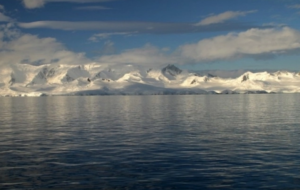When figuring out a solution, it helps to approach a problem from every possible angle. The same can be said for climate change-induced ice melt in the Antarctic, which is why the International Thwaites Glacier Collaboration (ITGC) programmed an automated underwater vehicle (AUV)—nicknamed “Ran”—to dive into the cavity of the Dotson Ice Shelf, located near Thwaites Glacier in West Antarctica.
Over the course of 27 days, the submarine traveled more than 600 miles—including 10 miles directly into the cavity itself—to both figure out the mechanics of how glaciers melt faster near strong underwater currents and glimpse the topography of this all-important ice shelf. What the experts behind this submersible found is that the attributes along the western part of the ice shelf differ greatly with the eastern portion, which is thicker and therefore melting more slowly.
The Ran AUV also produced high resolution maps of the underside of the Dotson Ice Shelf that revealed strange tear-drop features, icy plateaus, and detailed erosion patterns. The results of the study were published last week in the journal Science Advances.
“We have previously used satellite data and ice cores to observe how glaciers change over time,” Anna Wåhlin, the lead author of the study, said in a press statement. “By navigating the submersible into the cavity, we were able to get high resolution maps of the ice underside. It’s a bit like seeing the back of the Moon.”
Continue here: Popular Mechanics
Ask me anything
Explore related questions





